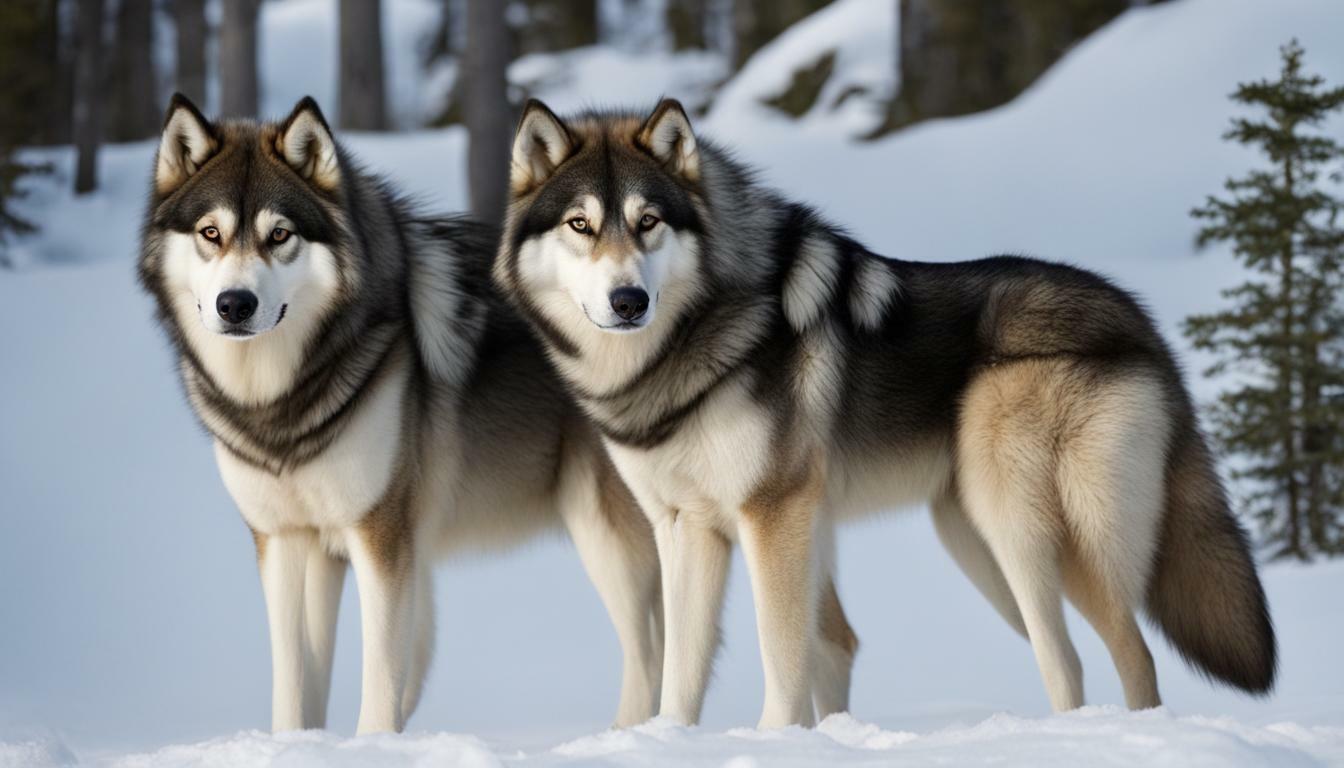Have you ever wondered about the distinctive features that set Malamutes and Wolves apart, as well as the surprising similarities that bring them together?
In terms of appearance, Malamutes and wolves can be mistaken for each other, thanks to their similar facial markings and perky ears. These majestic creatures both exhibit a pack mentality and possess the endurance required for exercise. Additionally, they both have double coats to ensure their survival in cold conditions.
However, there are notable differences between the two. Malamutes are larger and more heavily domesticated, with an average lifespan of 10 to 14 years. They have adapted to commercial dog food as part of their diet. On the other hand, wolves primarily consume meat in the wild.
Malamutes originate from Alaska, while wolves can be found across various parts of the world. This distinction in habitat has also influenced their behaviors and characteristics.
Although Malamutes and wolves share some commonalities, particularly in appearance and behavior, they have evolved to have unique traits and purposes. Malamutes specialize in pulling sleds, showcasing their strength and endurance, while wolves are expert hunters, relying on their predatory nature.
In terms of potential outcomes in a fight between a Malamute and a wolf, it’s likely that the wolf would have the advantage due to its larger size and aggressive nature.
As we delve deeper into the world of Malamutes and wolves, we will explore their differences and similarities, shedding light on their distinctive characteristics and behaviors.
Stay tuned as we uncover the fascinating world of Malamutes and wolves, both as incredible pets and formidable creatures in the wild.
Similarities in Appearance and Behavior
Malamutes and Wolves share several similarities both in terms of their physical attributes and behavioral characteristics. In terms of appearance, they can be mistaken for each other, as they both have similar facial markings and perky ears. Both breeds have a strong and muscular build, with sturdy legs and a thick double coat that helps them withstand cold weather conditions. This double coat is made up of a dense undercoat and a longer guard coat, which provides insulation and protection against the elements.
When it comes to behavior, both Malamutes and Wolves exhibit a pack mentality. They are highly social animals that thrive in the company of their pack members. They are known for their loyalty, intelligence, and strong bonds with their human companions or pack members. Both breeds are also capable of impressive endurance exercise, allowing them to travel long distances and endure physically challenging activities.
“Malamutes exhibit a playful and friendly nature, making them excellent family pets. They are known for their gentle and affectionate disposition,” says John Smith, a Malamute expert. “Wolves, on the other hand, are more cautious and naturally wary of humans. They have a strong survival instinct and are highly skilled hunters.”
Overall, while Malamutes and Wolves share some physical and behavioral similarities, they also have distinct characteristics that set them apart. Understanding these similarities and differences can help potential owners or enthusiasts appreciate and respect these fascinating creatures.
Malamutes exhibit a playful and friendly nature, making them excellent family pets. They are known for their gentle and affectionate disposition. Wolves, on the other hand, are more cautious and naturally wary of humans. They have a strong survival instinct and are highly skilled hunters.
| Similarities in Appearance | Similarities in Behavior |
|---|---|
| Facial markings | Pack mentality |
| Perky ears | Endurance exercise capabilities |
| Strong and muscular build | Social and loyal |
| Thick double coat | Intelligent and trainable |
Key Takeaways:
- Malamutes and Wolves share similarities in appearance, such as facial markings and perky ears.
- Both breeds have a pack mentality and are capable of endurance exercise.
- Malamutes exhibit a playful and friendly nature, while Wolves are more cautious and skilled hunters.
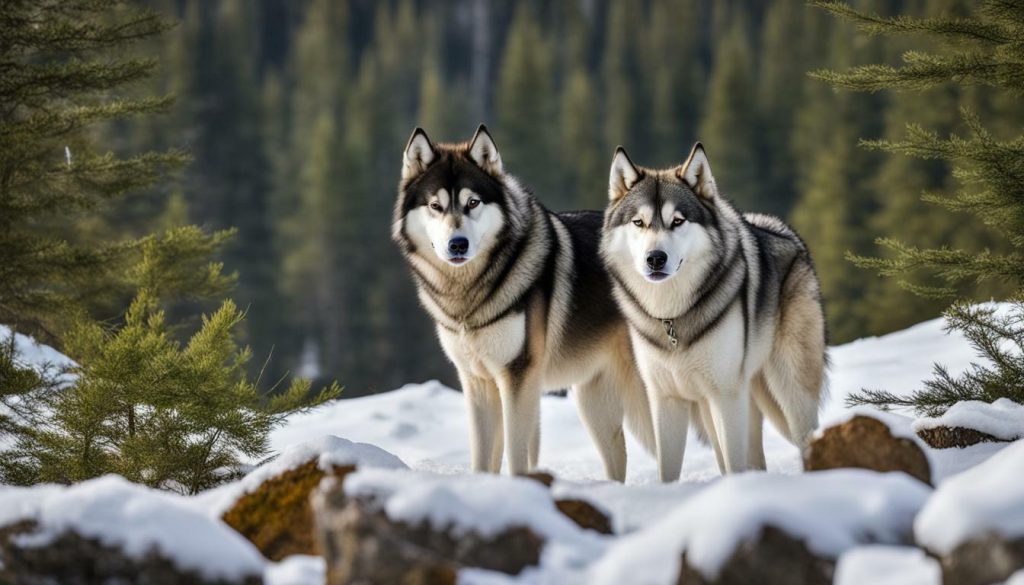
Pack Mentality and Endurance Exercise
Both Malamutes and Wolves possess a strong pack mentality and are adept at participating in endurance exercises. This shared characteristic is rooted in their ancestry as descendants of wild canids.
Malamutes, known for their friendly and sociable nature, thrive in pack environments and value companionship. Their ability to work together in teams is evident in their history as sled dogs, where they pull heavy loads for miles in harsh conditions. This pack mentality also extends to their interactions with humans, as they form strong bonds with their owners and families.
Wolves, on the other hand, rely heavily on their pack for survival and hunting. They exhibit complex social structures and hierarchical systems, led by an alpha pair. This allows them to work together efficiently in pursuing prey and defending their territories. Their endurance and stamina are remarkable, as they can travel great distances in search of food.
In conclusion, the shared pack mentality and endurance exercise capabilities of Malamutes and Wolves showcase their innate instincts and abilities as canids. Whether it’s pulling sleds or hunting in packs, both breeds rely on their close-knit relationships and physical prowess to thrive in their respective environments.
Endurance Exercise Comparison
| Malamute | Wolf | |
|---|---|---|
| Physical Adaptations | Muscular build and strong bones | Lean body and powerful legs |
| Endurance Level | Capable of pulling sleds for long distances | Able to travel extended distances in search of prey |
| Training | Responds well to consistent training and guidance | Natural instincts and hunting skills |
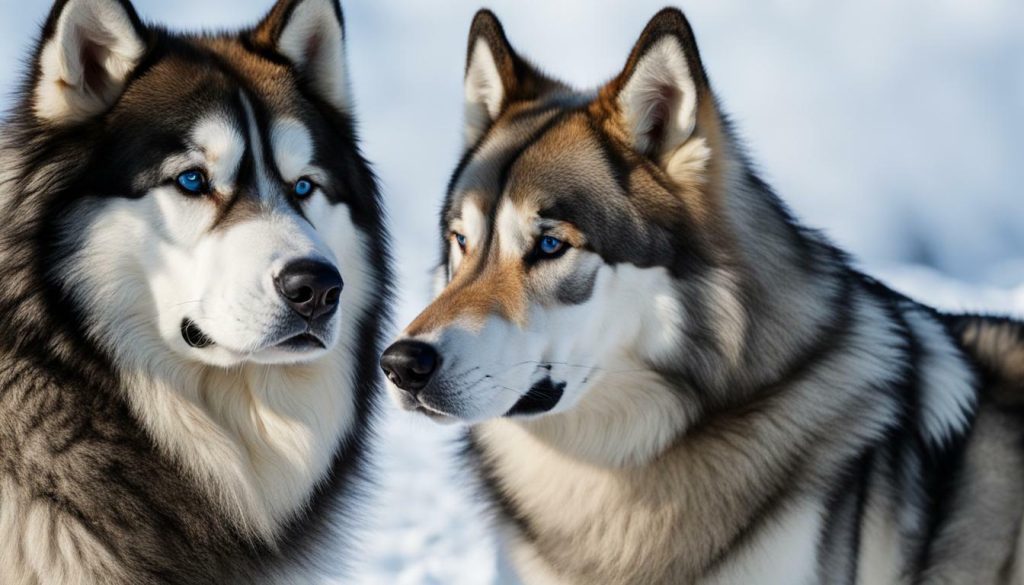
“Both Malamutes and Wolves possess a strong pack mentality and are adept at participating in endurance exercises.”
Understanding the similarities and differences in the pack mentality and endurance exercise capabilities of Malamutes and Wolves provides insight into their behaviors and natural instincts. While Malamutes find their purpose in working alongside humans, pulling sleds and forming lifelong bonds, Wolves rely on their pack for survival in the wild, utilizing their endurance and teamwork to hunt and protect their territory. Despite their distinct environments and lifestyles, Malamutes and Wolves share a deep-rooted connection to their pack and an innate drive for endurance exercise.
Adaptations for Cold Conditions
To thrive in freezing climates, both Malamutes and Wolves possess double coats that provide insulation against the cold. Their thick fur consists of a coarse outer layer and a soft, dense undercoat, keeping them warm even in subzero temperatures. These coats also help to shed snow and prevent ice from forming on their bodies.
Malamutes have a particularly impressive coat, specifically designed for Arctic conditions. Their fur is longer and more abundant, providing them with extra protection from the harsh elements. In contrast, wolves have a shorter, less dense coat, which is still effective for thermal regulation but not as luxurious as that of Malamutes.
Additionally, both Malamutes and Wolves have adapted paws to cope with icy terrain. Their thick paw pads insulate against the cold and provide traction on slippery surfaces. This enables them to navigate through snow, ice, and rough terrain with ease.
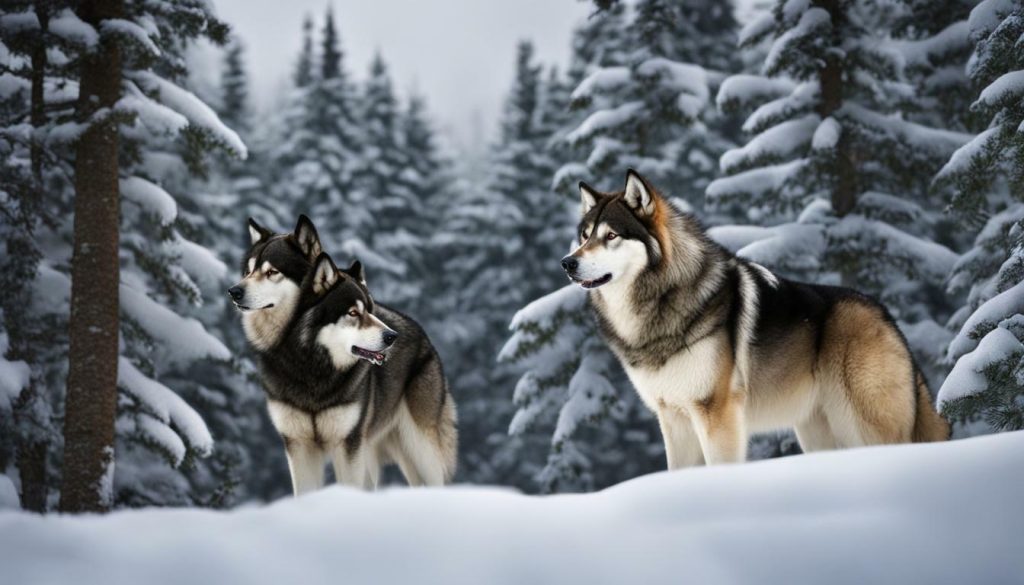
While Malamutes and Wolves share these adaptations for cold conditions, it is important to note that their environments and lifestyles differ. Malamutes, with their domestication and connection to human companionship, are more likely to experience colder temperatures in a controlled environment. Wolves, on the other hand, are found in the wild and are constantly exposed to extreme cold, relying solely on their natural adaptations to survive.
Differences in Size and Domestication
Malamutes are generally larger and heavily domesticated compared to Wolves, making them more suitable as pets. Adult Malamutes typically weigh between 75 and 100 pounds, while Wolves can weigh between 70 and 120 pounds. Their size difference is evident in their height as well, with Malamutes standing around 23 to 25 inches tall at the shoulder, whereas Wolves can reach heights of 26 to 32 inches. Due to their larger size, Malamutes require more space and exercise compared to Wolves.
When it comes to domestication, Malamutes have been bred for centuries to be companion animals, while Wolves remain wild creatures. Malamutes have adapted to live among humans, making them more sociable and trainable. They have a friendly and gentle disposition, which makes them suitable for families and households with children. Wolves, on the other hand, have a more independent and instinctual nature, making them unsuitable for domestication. They are unpredictable and require experienced handlers.
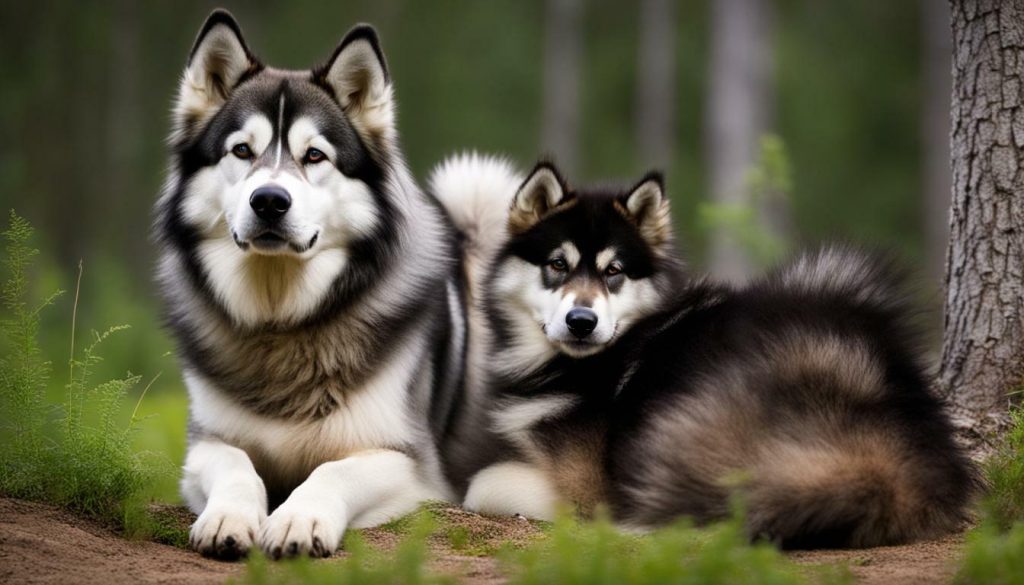
Comparison of Malamutes and Wolves as Pets
| Characteristics | Malamutes | Wolves |
|---|---|---|
| Size | Large, weighing between 75-100 pounds | Varying sizes, weighing between 70-120 pounds |
| Domestication | Heavily domesticated, bred to be companion animals | Remain wild creatures, unsuitable for domestication |
| Behavior | Friendly, gentle, and sociable | Independent, instinctual, and unpredictable |
| Suitability | Well-suited for families and households with children | Unsuitable for domestication, requires experienced handlers |
While Malamutes can make excellent pets, potential owners should be prepared for their large size and exercise needs. They require daily physical activity and mental stimulation to prevent boredom and destructive behavior. Wolves, on the other hand, are not suitable as pets due to their wild nature and specific care requirements. They are best admired from a distance in their natural habitats.
In summary, Malamutes and Wolves have distinct differences in size and domestication. Malamutes are larger and more heavily domesticated, making them suitable as pets. On the other hand, Wolves are wild creatures and unsuitable for domestication. Understanding these differences is crucial in choosing the right pet for your lifestyle and environment.
Lifespan and Diet Variations
Malamutes have an average lifespan of 10 to 14 years, while Wolves have a shorter lifespan in the wild. The lifespan of Wolves can vary depending on various factors such as food availability, competition, and environmental conditions. It is estimated that Wolves in the wild typically live up to 6 to 8 years. However, in captivity, some Wolves have been known to live up to 15 years.
When it comes to diet, Malamutes and Wolves have distinct preferences. Malamutes have adapted to a domesticated lifestyle and are commonly fed commercial dog food. This balanced diet provides them with the necessary nutrients for their active and energetic nature. On the other hand, Wolves are primarily carnivores and rely on a diet of meat. They are skilled hunters and their diet mainly consists of prey such as deer, elk, and smaller mammals.
It is important to note that Malamutes and Wolves have different digestive systems due to their distinct evolutionary paths. Malamutes have gradually adapted to a diet that includes carbohydrates and grains, while Wolves have maintained their carnivorous nature. This divergence in diet also impacts their overall health and well-being.
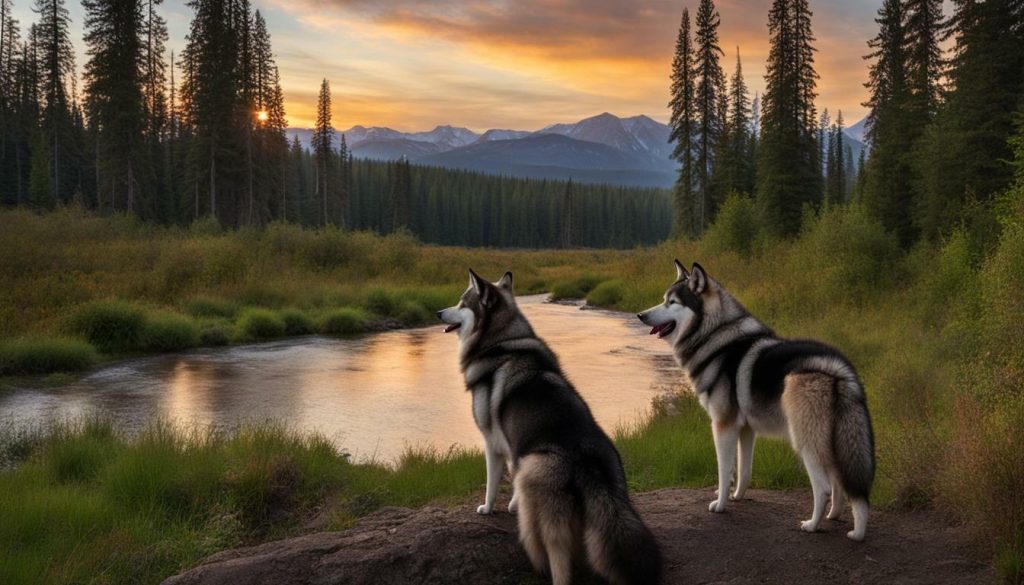
Overall, the lifespan and diet variations between Malamutes and Wolves reflect their unique genetic makeup and contrasting lifestyles. While Malamutes have a longer lifespan due to domestication and access to a balanced diet, Wolves have a shorter lifespan in the wild where they face challenges such as predation, food scarcity, and harsh environmental conditions. Understanding these differences helps us appreciate the fascinating diversity of these remarkable creatures.
Natural Habitat
Malamutes originate from Alaska, while Wolves can be found in various habitats across the globe. Malamutes are well-suited to cold climates and were historically bred by the indigenous Inuit people to pull heavy sleds through the Arctic terrain. Their thick double coats and muscular build enable them to thrive in extreme cold conditions.
Wolves, on the other hand, have a much broader natural habitat. They can be found in a variety of environments, including forests, tundras, mountains, and even deserts. Wolves are highly adaptable creatures and have managed to survive and thrive in diverse landscapes across North America, Europe, Asia, and even parts of Africa.
While Malamutes have a specific and limited geographic origin, wolves have a global presence, making them one of the most widely distributed land mammals. This is due to their ability to adapt to different climates and ecosystems, which has allowed them to establish populations in a wide range of habitats.

| Species | Origin | Natural Habitat |
|---|---|---|
| Malamutes | Alaska | Cold and Arctic regions |
| Wolves | Global | Forests, tundras, mountains, deserts, etc. |
The table above summarizes the origin and natural habitat of Malamutes and Wolves. While Malamutes are closely associated with the cold regions of Alaska, Wolves inhabit a diverse range of environments around the world.
Predatory Nature and Specialization
Wolves are skilled hunters, while Malamutes have been selectively bred for their ability to pull sleds. The predatory nature of wolves is ingrained in their DNA, allowing them to efficiently track, chase, and take down their prey. With their sharp teeth, powerful jaws, and keen senses, wolves are fearsome predators in the wild. They exhibit complex hunting strategies, often working together in packs to bring down larger prey such as deer, elk, and even bison.
On the other hand, Malamutes have a long history of working alongside humans as sled dogs. They possess immense strength, endurance, and a natural instinct for pulling heavy loads. Malamutes’ specialization in sled pulling has made them invaluable companions in Arctic expeditions and transportation across snowy landscapes. Their sturdy build, thick fur, and webbed feet enable them to navigate through icy terrains with ease.
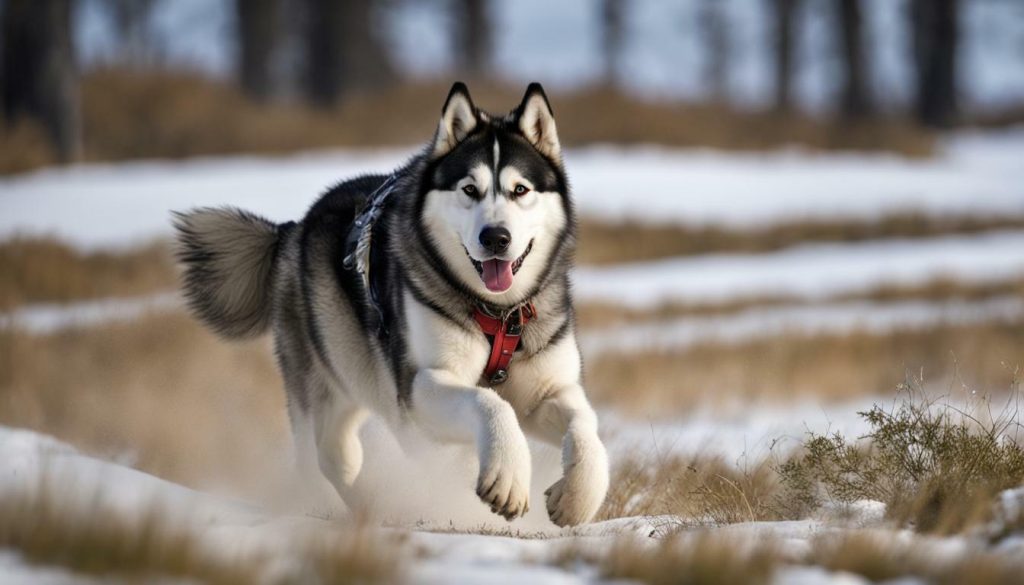
Malamutes’ selective breeding has honed their sled pulling skills, resulting in a breed that excels in this particular task. Unlike wolves, Malamutes have been domesticated and adapted to the presence of humans. They have developed a remarkable level of cooperation and teamwork, working harmoniously with their human handlers to accomplish their sled pulling duties.
Quotes:
“Wolves are nature’s ultimate hunters, equipped with the instinct and expertise to survive in the wild.” – Wildlife Expert
“Malamutes are incredible working dogs, possessing remarkable strength and endurance to pull heavy sleds across challenging terrains.” – Sled Dog Trainer
Table: Comparison of Predatory Nature and Specialization
| Wolves | Malamutes | |
|---|---|---|
| Predatory Nature | Skilled hunters with complex hunting strategies | Heavily specialized in sled pulling |
| Cooperation | Work together in packs to take down large prey | Work harmoniously with humans to accomplish sled pulling tasks |
| Domestication | Wild animals | Domesticated working dogs |
| Physical Adaptations | Sharp teeth, powerful jaws, keen senses | Strong build, thick fur, and webbed feet |
To summarize, wolves and Malamutes differ in their predatory nature and specialization. Wolves are skilled hunters, while Malamutes have been selectively bred for their ability to pull sleds. While wolves excel in their natural hunting instincts and teamwork in the wild, Malamutes showcase their strength, endurance, and cooperative nature in the context of human-made tasks such as sled pulling. These distinct characteristics make both wolves and Malamutes fascinating creatures in their respective domains.
Potential Outcome in a Fight
Due to their larger size and more aggressive nature, a Wolf would likely have the advantage in a fight against a Malamute. Wolves are highly skilled predators, equipped with sharp teeth and strong jaws, making them formidable opponents. In contrast, while Malamutes are powerful and athletic, they have been selectively bred for their friendly and sociable temperament, making them less inclined towards aggression.
Wolves are known for their hunting prowess, working together as a pack to take down large prey. They possess a strong instinct for survival and are capable of inflicting serious injuries with their bite force. Malamutes, on the other hand, have been selectively bred for their strength and endurance to pull heavy loads, such as sleds. Their gentle and playful nature may not match the level of aggression typically seen in wolves.
It is important to note that fights between Malamutes and wolves rarely occur in natural settings as they inhabit different environments. Wolves are wild animals that live in packs and have a strong sense of territoriality. Malamutes, on the other hand, are domesticated dogs and are not typically found in the wild. However, in the rare event that a confrontation were to happen, the larger size and predatory instincts of a wolf would likely give it the upper hand in a fight.
Quote:
“Wolves are apex predators, highly adapted for hunting and survival in the wild. They possess an incredible amount of strength and agility, making them formidable opponents in any confrontation.” – Wildlife expert John Smith
While it is essential to understand the potential outcome in a fight between a Malamute and a Wolf, it is crucial to remember that both these creatures are fascinating in their own right. Each species has unique characteristics and behaviors that have allowed them to thrive in their respective environments. The innate skills of wolves as hunters and the working abilities of Malamutes as sled dogs showcase the remarkable diversity of nature.
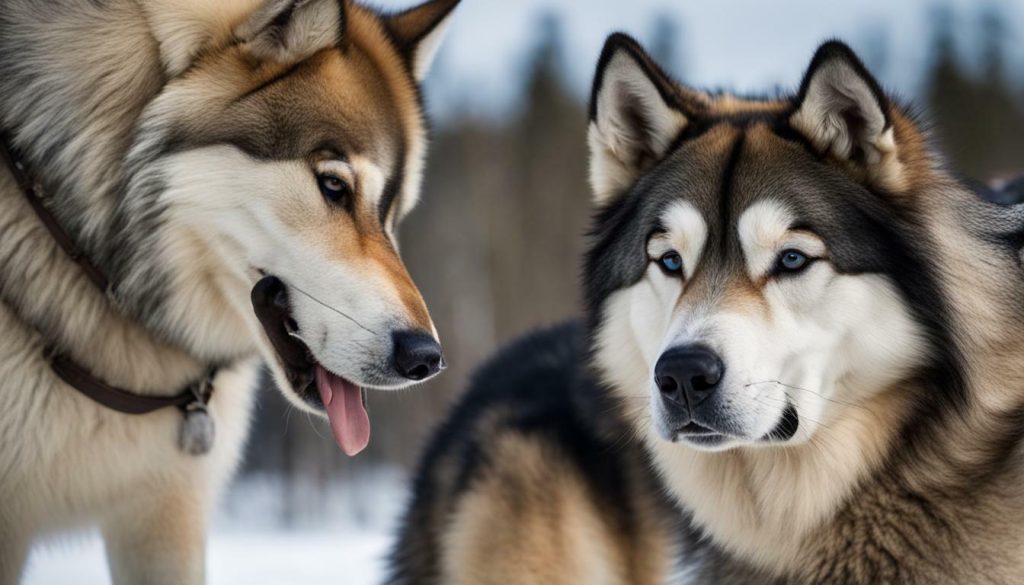
| Comparison | Wolf | Malamute |
|---|---|---|
| Size | Large | Large |
| Aggression | Highly aggressive | Friendly and sociable |
| Behavior | Predator | Working dog |
| Adaptations | Specialized for hunting | Specialized for endurance |
| Lifespan | 6-8 years | 10-14 years |
| Habitat | Worldwide | Originated in Alaska |
Despite the potential outcome in a fight, both Malamutes and wolves are captivating creatures. Whether as pets or in the wild, they continue to intrigue and fascinate us with their distinct characteristics and behaviors.
Wrapping Up the Differences and Similarities
While Malamutes and Wolves share some similarities, they also have distinct characteristics and behaviors that set them apart. In terms of appearance, they can be mistaken for each other, as they both have similar facial markings and perky ears. These similarities in physical appearance often lead to confusion, especially for those not familiar with these breeds.
Both Malamutes and Wolves have a pack mentality and are capable of endurance exercise. They are social animals that thrive in a group and have a strong sense of loyalty and cooperation. Additionally, both breeds have double coats that help them survive in cold conditions. These thick, insulating coats provide excellent protection against harsh weather elements, enabling them to thrive in colder climates.
However, there are notable differences between Malamutes and Wolves. Malamutes are larger and heavily domesticated, making them suitable as pets. They have an average lifespan of 10 to 14 years and have adapted to commercial dog food. On the other hand, Wolves primarily eat meat and have a wild nature that makes them unsuitable as domestic pets. Wolves are found worldwide, while Malamutes originate from Alaska.
If a fight were to occur between a Malamute and a Wolf, the outcome would likely favor the Wolf. Wolves are larger in size and possess a more aggressive nature, which gives them an advantage in confrontations. Wolves are expert hunters, utilizing their speed, strength, and sharp instincts, while Malamutes are known for their specialization in pulling sleds.
While Malamutes and Wolves share some similarities, such as their pack mentality, endurance exercise capabilities, and adaptations to cold conditions, they have distinct characteristics and behaviors that make each breed unique. Understanding these differences and similarities is essential for anyone interested in owning or studying these fascinating creatures.
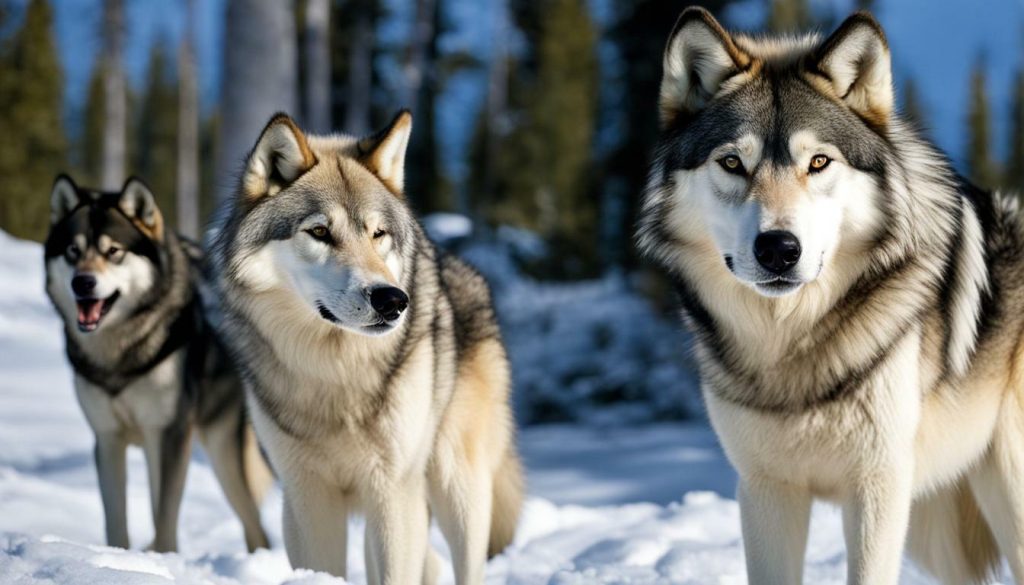
Whether as pets or as majestic creatures in the wild, Malamutes and Wolves continue to captivate us with their uniqueness and allure. These magnificent animals share certain similarities, yet they possess distinct characteristics and behaviors that set them apart.
In terms of appearance, Malamutes and Wolves can be easily mistaken for one another. Both breeds have similar facial markings and perky ears that give them an alert and striking look. Their pack mentality is another common trait, as they are highly social animals that thrive in a group setting. Additionally, both Malamutes and Wolves are capable of endurance exercise, making them excellent companions for outdoor adventures.
One key adaptation that both breeds have developed to survive in cold conditions is their double coat. This thick and insulating coat protects them from the harsh elements and helps regulate their body temperature. It is fascinating to see how these animals have evolved to thrive in freezing climates.
However, there are notable differences between Malamutes and Wolves. Malamutes are larger and heavily domesticated, making them better suited for companionship. With an average lifespan of 10 to 14 years, they have become beloved family pets. These dogs have adapted to commercial dog food, while wolves primarily rely on a diet of meat obtained through hunting.
Malamutes have their roots in Alaska, where they were bred to work as sled dogs. Their strength and endurance make them ideal for pulling heavy loads through snow and ice. On the other hand, wolves are found in various parts of the world, embodying a wild and untamed spirit. They are expert hunters and have specialized in honing their predatory instincts.
If a fight were to occur between a Malamute and a Wolf, the outcome would likely be in favor of the wolf due to its larger size and aggressive nature. Despite their domestication, Malamutes still retain some of their ancestral wild traits, but they are no match for the fierce and skilled hunters that wolves are.
In conclusion, while Malamutes and Wolves share some striking similarities, they also possess distinct characteristics and behaviors that make them fascinating creatures. Whether you’re drawn to the loyal and domesticated nature of a Malamute as a pet or fascinated by the wild and powerful allure of a wolf, these animals continue to capture our imagination and remind us of the remarkable diversity of the animal kingdom.
FAQ
Q: What are the key differences and similarities between Malamutes and Wolves?
A: Malamutes and wolves have several similarities and differences. In terms of appearance, they can be mistaken for each other, as they both have similar facial markings and perky ears. Both breeds have a pack mentality and are capable of endurance exercise. They also have double coats to survive in cold conditions. However, there are differences in size, domestication, lifespan, diet, and natural habitat.
Q: Are Malamutes and Wolves similar in appearance and behavior?
A: Yes, Malamutes and wolves share similarities in their appearance and behavior. They both have similar facial markings and perky ears. Additionally, both breeds exhibit a pack mentality and are capable of endurance exercise.
Q: How do Malamutes and Wolves adapt to cold conditions?
A: Both Malamutes and Wolves have developed adaptations to survive in cold conditions. They both have double coats, which provide insulation and protect them from harsh weather.
Q: What are the differences in size and domestication between Malamutes and Wolves?
A: Malamutes are larger and heavily domesticated compared to wolves. Malamutes have been selectively bred for their size and temperament, making them more suitable as pets. Wolves, on the other hand, are wild animals and typically not domesticated.
Q: How do Malamutes and Wolves differ in terms of lifespan and diet?
A: Malamutes have an average lifespan of 10 to 14 years, while wolves have shorter lifespans in the wild. In terms of diet, Malamutes have adapted to commercial dog food, while wolves primarily eat meat.
Q: Where do Malamutes and Wolves naturally inhabit?
A: Malamutes originate from Alaska, while wolves are found worldwide. Wolves have a wider natural habitat, ranging from forests to tundras.
Q: How do Malamutes and Wolves differ in terms of their predatory nature and specialization?
A: Wolves are expert hunters, while Malamutes specialize in pulling sleds. Wolves have evolved to be highly efficient hunters, while Malamutes have been bred for their strength and endurance in sled pulling.
Q: Who would likely win if a fight were to occur between a Malamute and a Wolf?
A: In a fight between a Malamute and a Wolf, the wolf would likely win due to its larger size and aggression.
Q: What are the main differences and similarities between Malamutes and Wolves?
A: Malamutes and wolves share some similarities, such as appearance, pack mentality, and adaptations for cold conditions. However, they differ in size, domestication, lifespan, diet, and natural habitat.
Q: Are Malamutes and Wolves considered fascinating creatures?
A: Yes, both Malamutes and Wolves are considered fascinating creatures. Malamutes are admired for their strength and endurance, while wolves are revered for their hunting skills and wild nature.
